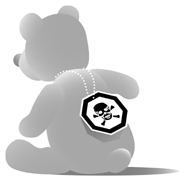Home is where the harm is
Ah, there's nothing like returning from an evening lecture to the comforts of home. Unless you've just returned from "Our Home: Haven or Hazard," with Professors David Harpp, Ariel Fenster and Joe Schwarcz from the McGill Office for Science and Society.

The attendees of the October 16 talk probably went home appreciating the benefits of soaps and detergents, but concerned about some other cleaning agents. Some may even have considered ripping up their carpets and fumigating their mattresses.
David Harpp kicked off the evening with an explanation of the Office of Science in Society, and the work they do in explaining science in everyday life. He noted that anyone interested in their work can access their website (www.oss.mcgill.ca). You can also see their lecture with audio accompaniment on the Courses On-Line site (cool.mcgill.ca).
Ariel Fenster's talk was a bit of a wash. He gave the assembled crowd the dirt on cleaning products like soap, shampoo, detergent and fabric softener.
Soap has been around for quite some time, explained Fenster, quoting Jeremiah "For though thou wash thee with nitre, and take thee much soap, yet thine iniquity is marked before me, saith the Lord God."
Indeed, few chemical processes have been around longer: winemaking is one, said Fenster, proving "the desire to get clean came after the desire to get drunk."
Soap is the result of animal fats being broken down by alkali. The molecule that results is a sodium salt with a long chain of carbons as a tail. There are different kinds, but the most common is sodium stearate.
"Soap is a fantastic molecule: it has a dual nature," said Fenster, explaining that the structure of the soap molecule is where it gets its cleaning power.
The "head" of the soap molecule is hydrophilic, meaning it is attracted to water. The tail is repelled by water. This combination allows the tail to break down dirt and grease, and then be borne away by the good offices of the head of the molecule and water.
Fenster also shed light on the mysteries of detergents. They work on the same principle as soap, but react less to hard water.
Fenster also shared some home economy tips for his audience. Looking for ways to trim your beauty budget?
"You can save a lot of money. Instead of using shampoo, just use your liquid dishwashing detergent and it will have the same effect," said Fenster, who pointed out that in terms of active chemistry, shampoo and dishwashing detergent is the same thing.
"You will want to use the nicely scented ones though."

Tzigane
Smell is in fact what drives a lot of the cosmetics and hygiene industry. Fenster said we're putting more fragrances into more products than ever before, and this is having effects on our health. Commercial scents can aggravate migraines, dermatitis, asthma and a host of other ailments.
In fact, Fenster pointed to a case in Florida where a woman is charged with trying to kill her husband with smell. The man was diagnosed with multiple chemical sensitivities and had received a worker's compensation payout that he refused to share with his wife. Her response was to spray him with Lysol.
Fenster pointed out that we spend $10 billion a year on fragrances, the most popular of which is Chanel No 5. "Interestingly, women do not like this scent. It is mostly bought by men."
Joe Schwarcz led off his portion of the evening with the observation that most homeowners are chemists of a sort.
"Today, in a modern home you have more chemicals than you would have had in a chemistry lab 100 years ago," he said.
He then began to describe a litany of things in your home that can be harmful. Mixing acidic toilet bowl cleaners with bleach is a big no-no: "Doing this can cause you to wake up dead." The reason? The sulphuric acid in the cleaner mixes with the bleach, releasing toxic chlorine gas.
You don't want to put away the bleach though -- it's the best way to kill mould, which can also sometimes be toxic.
Drano and the kind of Liquid Plumber that contains sulfuric acid are nearly as dangerous. The acid in the Liquid Plumber can mix with sodium hydroxide in the Drano. In combination, these two create an exothermic reaction (in other words, heat) that is strong enough to melt plastic pipes.
"I don't want to scare you here, because the chance of these problems happening is very small," said Schwarcz to his visibly nervous audience.
Schwarcz then moved on to the tale of an 11-month-old infant who developed mercury poisoning after his mother broke a thermometer on the floor.
"She thought she had picked it all up, but she missed one drop, and that was enough," he said.
Ah, the hazards of a carpeted floor. Schwarcz didn't have much that was nice to say about a good shag: carpeting traps all manner of contaminants tracked in from the outside, or generated in the home.
Ol' Teddy hides a potentially deadly secret, too. "Stuffed animals harbour all sorts of allergenic and toxic materials."
But surely a good vacuuming will clean everything up? Not unless you want to devote the rest of your life to Hoovering. Schwarcz said studies have shown that to properly clean a carpet, you must make 25 passes with your vacuum in high traffic areas.
Animal lovers might not want to clean their carpets in the end.
"If you were to take a close look at your carpet you'd be amazed not just by the contaminants, but also by the wildlife," he said. Dust mites -- microscopic insects that live on dead skin cells -- thrive in our carpets, on our bodies and in our beds. Their waste can be an allergen, and over years they have been known to generate grams of fecal matter inside mattresses.
"So remember when you go to bed tonight," said Schwarcz, "you are not alone."
